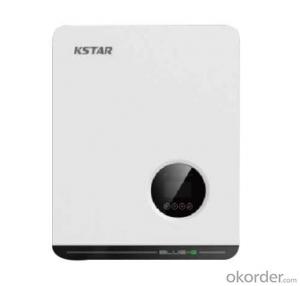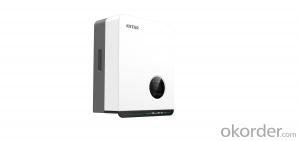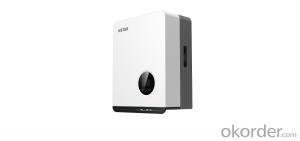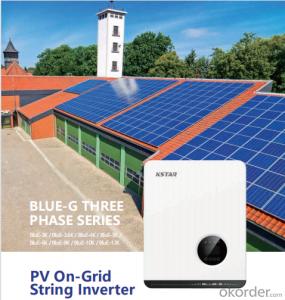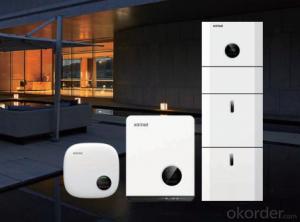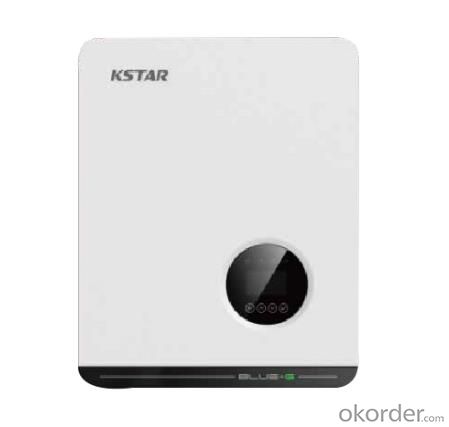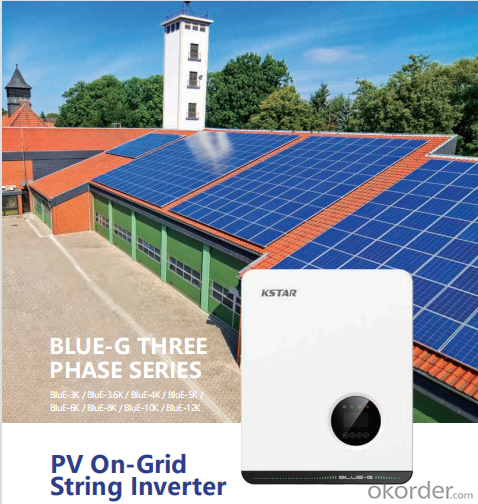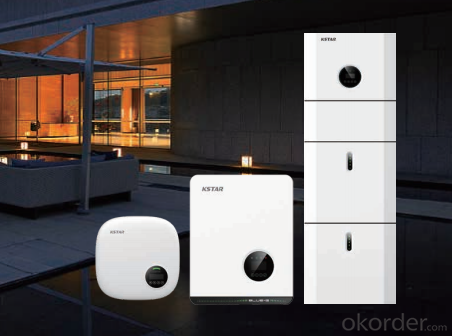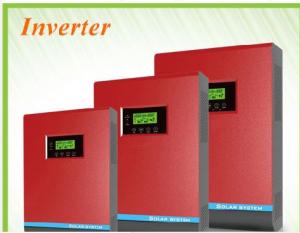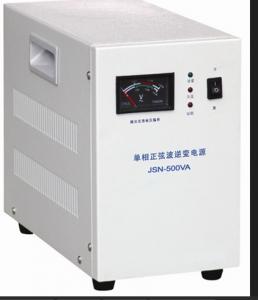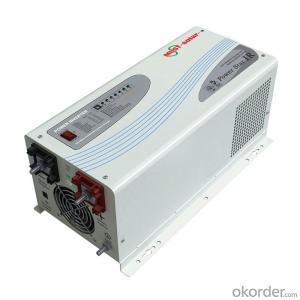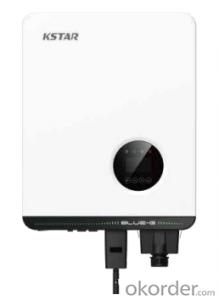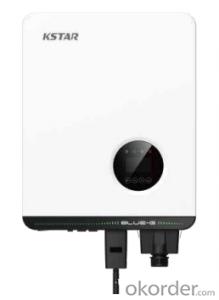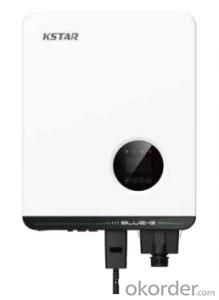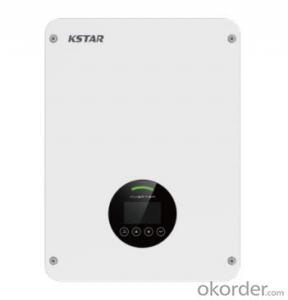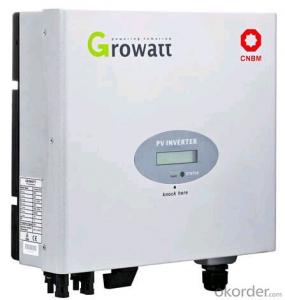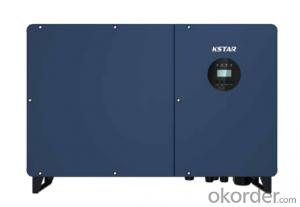Cheap Solar Inverter PV On-Grid String Inverter Blue-3KT ~ Blue-12KT
- Loading Port:
- China main port
- Payment Terms:
- TT OR LC
- Min Order Qty:
- 50 pc
- Supply Capability:
- 15000 pc/month
OKorder Service Pledge
OKorder Financial Service
You Might Also Like
Specification
Product Description:
★Max. PV voltage up to 1100V Type II DC /AC SPD
★DC/AC ratio up to 2 IP66 protection
★High efficiency up to 98.6% Smaller and lighter
★Compatible for big capacity PV panel WiFi / 4G Plug optional
Technical Specifications:
| MODEL | BluE-3KT | BluE-3.6KT | BluE-4KT | BluE-5KT | BluE-6KT | BluE-8KT | BluE-10KT | BluE-12KT |
| Input(DC) | ||||||||
| Max. DC Voltage | 1100V | 1100V | 1100V | 1100V | 1100V | 1100V | 1100V | 1100V |
| Nominal Voltage | 620V | 620V | 620V | 620V | 620V | 620V | 620V | 620V |
| Start Voltage | 180V | 180V | 180V | 180V | 180V | 180V | 180V | 180V |
| MPPT Voltage Range | 140V-1000V | 140V-1000V | 140V-1000V | 140V-1000V | 140V-1000V | 140V-1000V | 140V-1000V | 140V-1000V |
| Number of MPP Tracker | 2 | 2 | 2 | 2 | 2 | 2 | 2 | 2 |
| Strings Per MPP Tracker | 1 | 1 | 1 | 1 | 1 | 1 | 1 | 1 |
| Max. Input Current Per MPPT | 15A | 15A | 15A | 15A | 15A | 15A | 15A | 15A |
| Max. short-circuit Current Per MPPT | 20A | 20A | 20A | 20A | 20A | 20A | 20A | 20A |
| Output(AC) | ||||||||
| Nominal AC Output Power | 3000W | 3600W | 4000W | 5000W | 6000W | 8000W | 10000W | 12000W |
| Max. AC Apparent Power | 3300VA | 3960VA | 4400VA | 5500VA | 6600VA | 8800VA | 11000VA | 13200VA |
| Nominal AC Voltage | 400V 3L+N | |||||||
| AC Grid Frequency Range | 50Hz / 60Hz(±5Hz) | |||||||
| Max. Output Current | 4.8A | 5.8A | 6.4A | 8.0A | 9.6A | 12.8A | 16.0A | 19.2A |
| Power Factor (cosφ) | 0.8 leading to 0.8 lagging | |||||||
| THDi | <3%< td=""> | |||||||
| Efficiency | ||||||||
| Max. Efficiency | 98.40% | 98.40% | 98.40% | 98.40% | 98.40% | 98.60% | 98.60% | 98.60% |
| Euro Efficiency | 97.50% | 97.50% | 97.50% | 97.50% | 97.50% | 98.00% | 98.10% | 98.10% |
| Protection devices | ||||||||
| DC switch | Yes | |||||||
| Anti-islanding Protection | Yes | |||||||
| Output Over Current | Yes | |||||||
| DC Reverse Polarity Protection | Yes | |||||||
| String Fault Detection | Yes | |||||||
| AC/DC Surge Protection | DC: Type II / AC: Type III / Type II Optional | |||||||
| Insulation Detection | Yes | |||||||
| AC Short Circuit Protection | Yes | |||||||
| General Specifications | ||||||||
| Dimensions W x H x D (mm) | 380*438*161 | |||||||
| Weight(kg) | <17 | |||||||
| Operating Temperature Range | –25℃~+60℃ | |||||||
| Cooling Type | Natural Cooling | |||||||
| Max. Operation Altitude | ≤4000m | |||||||
| Max. Operation Humidity | 0-100%(No condensation) | |||||||
| AC Output Terminal Type | Quick Connector | |||||||
| IP Class | IP66 | |||||||
| Topology | Transformer-less | |||||||
| Communication Interface | RS485/WIFI/4G | |||||||
| Display | LCD | |||||||
| Certification & Standard | EN/IEC62109-1/2;IEC/EN61000-6-2;IEC/EN61000-6-4;IEC61683;IEC60068;IEC60529;IEC62116;IEC61727; EN50549-1;AS 4777.2;VDE-AR-N-4105;VDE 0126-1-1;CEI0-21;G98;G99;C10/C11;NB/T32004-2018;GB/T19964-2012 | |||||||
Q:How the output voltage of the PV inverter and the grid-connected voltage are determined
Inverter is the DC power (battery, battery) into alternating current (usually 220V, 50Hz sine wave). It consists of inverter bridge, control logic and filter circuit. Widely used in air conditioning, home theater, electric wheel, power tools, sewing machines, DVD, VCD, computer, TV, washing machine, range hood, refrigerator, video recorders, massage, fan, lighting and so on. In foreign countries
Q:Installation and maintenance of photovoltaic grid - connected inverter
only when the local power sector permission by the professional and technical personnel to complete all the electrical connection before the inverter can be connected.
Q:What is the difference between a PV grid-connected inverter and an off-grid inverter?
Off-grid inverter is equivalent to their own to establish an independent small power grid, mainly to control their own voltage, is a voltage source.
Q:After the PV inverter, how to achieve the same period before the network?
Solar panel simulator: with MPPT function, simulated morning, noon, afternoon, evening, rainy weather, solar panels produced under different conditions in different voltages.
Q:Is the PV inverter a current source or a voltage source?
According to the waveform modulation method can be divided into square wave inverter, stepped wave inverter, sine wave inverter and modular three-phase inverter.
Q:Photovoltaic grid-connected inverter without DC emc how will happen
Solar photovoltaic power generation technology is the use of solar cells, the photovoltaic effect of semiconductor materials, solar radiation can be directly converted into a new type of power generation system, solar energy is a radiant energy, solar power means --- to direct conversion of sunlight Into electricity,
Q:What is the difference between low voltage grid connection and medium voltage grid connection?
For photovoltaic power plants when the power system accidents or disturbances caused by photovoltaic power plant grid voltage drop, in a certain voltage drop range and time interval, the photovoltaic power plant can ensure that non-off-line continuous operation.
Q:Is the grid side of the grid and the inverter?
The grid load side of the grid is the grid. The inverter is an important part of the PV grid-connected system and can not be regarded as an external load. Photovoltaic power generation system is included in both grid and off-grid.
Q:PV grid-connected inverter and independent inverter in the control of what is the difference
The independent inverter in the output voltage phase amplitude of the frequency control is initially set good. Independent inverter, you should refer to off-grid inverter, do not need to consider the grid situation.
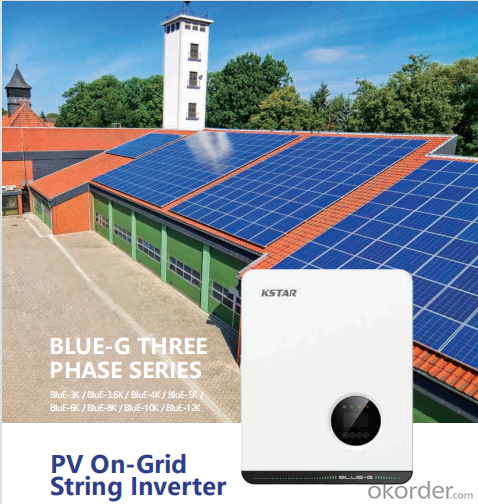
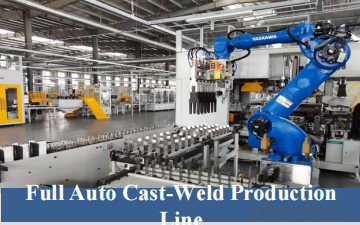
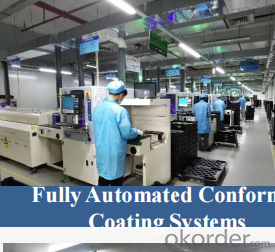
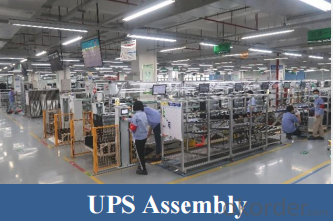
- Q: What are the common maintenance requirements for a solar inverter?
- The common maintenance requirements for a solar inverter include regular inspections to ensure proper functioning, cleaning of the unit and its components to remove dust and debris, checking and tightening of electrical connections, monitoring for any signs of damage or wear, and updating firmware or software as needed. Additionally, keeping the inverter's surrounding area clean and free from obstructions is also important for optimal performance.
- Q: How does a solar inverter handle voltage and frequency variations caused by grid faults?
- Grid support or anti-islanding function is the process by which a solar inverter manages voltage and frequency variations resulting from grid faults. It promptly detects disturbances, such as sudden drops or spikes in voltage or frequency, and responds accordingly. To address voltage variations, the solar inverter incorporates a voltage control mechanism. It continuously monitors the grid voltage and adjusts its own output voltage to match the grid level. In the event of a voltage drop or spike due to a grid fault, the inverter adjusts its output voltage to maintain a stable and secure operating condition. This safeguards both the solar system and the grid from potential harm. Similarly, the solar inverter handles frequency variations caused by grid faults. It constantly monitors the grid frequency and adjusts its own output frequency to align with the grid. If a grid fault results in a sudden frequency change, the inverter responds by adjusting its own frequency. This ensures the solar system remains synchronized with the grid and continues to provide uninterrupted power supply. Furthermore, solar inverters are equipped with anti-islanding protection. This feature enables them to quickly disconnect from the grid in the event of a grid fault. This safety measure prevents the solar system from supplying power to a faulty grid, thus minimizing risks to utility workers during repair. In summary, the solar inverter's capacity to handle voltage and frequency variations caused by grid faults is vital for the efficient and safe operation of a solar power system. By continuously monitoring and adjusting its output to match grid conditions, the inverter guarantees a stable and reliable power supply while keeping the solar system in sync with the grid.
- Q: Can a solar inverter be used with a solar-powered agriculture system?
- Yes, a solar inverter can be used with a solar-powered agriculture system. A solar inverter is essential for converting the direct current (DC) electricity produced by solar panels into alternating current (AC) electricity required to power electrical devices and equipment used in the agriculture system. This allows for the efficient utilization of solar energy for various agricultural applications such as irrigation systems, pumps, lighting, and other electrical equipment.
- Q: How do you choose the right size solar inverter for a specific solar power system?
- Choosing the right size solar inverter for a specific solar power system requires careful consideration of various factors. Here are some steps to help you make the right choice: 1. Determine your solar power system's capacity: Start by calculating the total capacity of your solar power system. This involves determining the total wattage of all your solar panels combined. This information can usually be found on the product specifications or by consulting with your solar panel manufacturer. 2. Consider your average energy consumption: Assess your average energy consumption to determine the size of the solar inverter needed to meet your requirements. Consider your peak power usage and any potential future increase in energy demands. 3. Evaluate the inverter's capacity: Match the capacity of the solar inverter with your solar power system's capacity. The inverter's capacity should be equal to or slightly higher than your system's total capacity to ensure optimal performance. 4. Consider the inverter's efficiency: Look for an inverter with high efficiency ratings. A higher efficiency rating means that it can convert a larger percentage of the solar energy into usable electricity, minimizing power losses. 5. Determine the inverter type: Decide on the type of solar inverter suitable for your system. There are three main types: string inverters, microinverters, and power optimizers. String inverters are the most common and cost-effective option for small to medium-sized systems, while microinverters and power optimizers are better suited for complex installations or systems with shading issues. 6. Assess the inverter's features: Consider additional features that the solar inverter may offer. Look for features such as monitoring capabilities, grid integration capabilities, and built-in safety features like arc fault protection or rapid shutdown. 7. Consult with professionals: If you are uncertain about the right size solar inverter for your specific solar power system, it is advisable to consult with a professional solar installer or an electrical engineer. They can help assess your energy needs, system requirements, and provide expert guidance on selecting the appropriate inverter size. Remember, choosing the right size solar inverter is crucial for the overall performance and efficiency of your solar power system. Taking the time to evaluate your system's requirements and seeking expert advice will help ensure you make an informed decision.
- Q: What are the common troubleshooting steps for a malfunctioning solar inverter?
- The common troubleshooting steps for a malfunctioning solar inverter include checking the display for error messages, inspecting the DC and AC connections for loose or damaged wires, verifying the input voltage and frequency, resetting the inverter, and monitoring the system for any unusual behavior. If these steps do not resolve the issue, it is advisable to consult a professional or contact the manufacturer for further assistance.
- Q: Can a solar inverter be used with a hybrid solar power system?
- Yes, a solar inverter can be used with a hybrid solar power system. A hybrid solar power system typically consists of both solar panels and a secondary power source, such as batteries or a diesel generator. The solar inverter converts the direct current (DC) power generated by the solar panels into alternating current (AC) power that can be used to power appliances and devices in the home or business. Additionally, the solar inverter can also manage the flow of power between the solar panels, the batteries, and the grid, optimizing energy usage and ensuring a reliable power supply.
- Q: Can a solar inverter be used in mobile applications?
- Yes, a solar inverter can be used in mobile applications. There are specifically designed solar inverters available that are compact and portable, making them suitable for use in mobile applications such as RVs, boats, and other vehicles. These inverters can convert the DC power generated by solar panels into AC power to run various devices and appliances on the go.
- Q: How does a solar inverter communicate with other devices?
- A solar inverter communicates with other devices through various communication protocols such as Wi-Fi, Bluetooth, Ethernet, or RS485. These protocols allow the inverter to connect and exchange information with devices such as monitoring systems, smart meters, or home automation systems. This communication enables real-time monitoring, data logging, and control of the solar energy system.
- Q: How does a solar inverter affect the overall system reliability?
- A solar inverter plays a crucial role in enhancing the overall system reliability of a solar power system. It converts the direct current (DC) generated by solar panels into alternating current (AC) that can be used to power household appliances and feed excess energy into the grid. By efficiently managing and controlling the flow of electricity, a reliable solar inverter ensures smooth operation of the entire system, preventing power fluctuations, voltage surges, and other electrical issues. Additionally, advanced features like anti-islanding protection and monitoring capabilities enable early detection and prevention of potential faults, further enhancing the system's reliability and performance.
- Q: What is the role of a power factor controller in a solar inverter?
- The role of a power factor controller in a solar inverter is to regulate and optimize the power factor of the system. It ensures that the power factor remains close to unity, helping to improve the efficiency and performance of the solar inverter. By controlling the power factor, the controller minimizes reactive power generation and reduces energy losses, ultimately enhancing the overall power quality and stability of the solar inverter system.
Send your message to us
Cheap Solar Inverter PV On-Grid String Inverter Blue-3KT ~ Blue-12KT
- Loading Port:
- China main port
- Payment Terms:
- TT OR LC
- Min Order Qty:
- 50 pc
- Supply Capability:
- 15000 pc/month
OKorder Service Pledge
OKorder Financial Service
Similar products
Hot products
Hot Searches
Related keywords
